► Road trip to Le Mans in a GT3 RS
► Behind the scenes in Porsche’s pitboxes
► Plus a pilgrimage to Porsche’s original Le Mans basecamp
Here’s one of those stats that makes you do a mental double-take: at least one Porsche has competed in every Le Mans 24h race since 1951. Remarkable really, when you think about it. First time a Porsche took to the Mulsanne (a 356 SL Aluminium Coupe, as it happens) was before disc brakes, before downforce, before Elvis had a hit record, even.
Le Mans 2019 chalked another year onto the Porsche scoreboard, with works and privateer 911 RSRs alike battling round the clock in the GTE Pro and Am classes. Less significantly, but very much memorably for me, I had a Porsche-Le Mans moment of my own as an unexpected opportunity arose to drive to and from the race in a 911 GT3 RS (the same car that starred in CAR’s 600LT-Performante-GT3 group test earlier this year).
Click here for CAR’s fan’s-eye view of Le Mans 2019 in pictures
Départ
The drive to Le Mans is as much a part of the event as the race itself, as thousands of car fans from different starting points (but an awful lot of them coming from the UK) converge on a nondescript yet hallowed patch of northern France. Even Steve McQueen’s 1971 movie homage to the race starts with his character driving to Le Mans. In a 911, of course.

In radioactive Lizard Green the 991.2 GT3 RS is not quite so subtle as McQueen’s grey Porsche 911 S – or as classy, subjectively – but it is massively alluring. With its race-derived aero kit and fat Michelins filling its arches it looks so serious it might just be able to grab a late entry in the 24h with the addition of some race numbers and a few sponsors’ stickers.
It’s hammering down with rain as I set off from the Midlands at Friday daybreak and the track-focused Cup 2 front tyres feel unsure of themselves on the cold, wet roads before they come up to pressure. I know from previous precious time in OPR 911 that it has huge front-end grip once they’ve warmed up, but the low-speed understeer is more eye-opening than an espresso at this murky pre-dawn hour.

As its optional (but essential) half-rollcage suggests, the GT3 RS is about as track-focused as a modern 911 gets, with so much sound-deadening removed in the name of weight-saving you can hear squeaks from the suspension and the brush of the brake pads when they bite the ceramic discs. And yet it’s genuinely civilised at a cruise; yes, there is quite a lot of road noise, especially on coarse surfaces, but there’s a stereo you can turn up to compensate. To be trundling down the motorway in a car capable of lapping the Nordschleife faster than a Porsche 918 Spyder yet with both cruise control and Radio 4 clicked on, and a cup of coffee in one of the dash’s cupholder speaks volumes about the GT3’s breadth of ability. (Although you do need to drink about a third of the coffee beforehand so that it doesn’t slop out of the cup when it wobbles in the cupholders’ spidery armatures’ shaky grasp).
Even the fixed-back carbon-shell seats are surprisingly comfortable over a long distance.
Joining the queue at the Channel Tunnel is like arriving at a car show. Maseratis, TVRs, classic Minis, a smattering of BMW M cars, and other 911s. Must be Le Mans weekend.
Rendez-vous
Just the other side of the tunnel I meet up with CAR’s Ben Miller and Jake Groves, Ben in a Toyota Supra and Jake in his R8 Spyder long-termer. They’re waiting at a Calais petrol station that’s turned into a haven for supercar-spotters. Polite but relentless French car fans armed with GoPros have travelled here in the knowledge it’ll be full of inbound enthusiast cars, and the GT3 RS is mobbed, spectators surrounding the car like its reached the end of a rally stage.
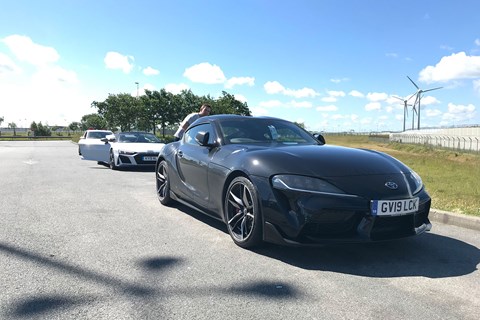
We strike out south in file, a convoi exceptionnel in the French sunshine. Jake’s R8 is out front, low, wide and purposeful and I lope along behind the Toyota Supra, its double-bubble roof and kick-up tail highlighted to best effect in shiny black paint. It looks like a Dodge Viper in miniature. Yet more car fans are waiting on bridge gantries all the way down the autoroutes, waving and cheering on the supercars and classics as they pass. Even hundreds of kilometres from Le Mans there’s a warm, friendly atmosphere going on, people bonded together by their shared interest in sports cars.
It feels a waste to be driving the GT3 RS, one of the world’s best driver’s cars, on a journey that’s entirely composed of motorways. Had we more time it’d be a car to leave the autoroute and take the long, wiggly route down but this trip is on a smash-and-grab time schedule. The 911 feels happy, though. The French tarmac is so smooth you can put the dampers in their firmer Sport mode so the car sits just so, and there are plenty of tunnels for the titanium exhaust to run through a few vocal exercises. At one point Jake and I run through a tunnel in tandem, roof down on the R8, windows down on the GT3, way below the speed limit and revs near the redline, both of us laughing our heads off at the joyous absurdity of it all.
Arrivée
There’s no chance to pause reflectively with the 911 in Le Mans town centre as per McQueen’s character in Le Mans, as the driver parade is in full swing. There’s a festival atmosphere, with carnival drums, streamers and the drivers riding through the city in open-topped classic cars, throwing tat (keyrings, pens, paper flags) to the throngs of fans, who can’t get enough of them. Porsche’s works drivers throw packets of 911-shaped sweets and onlookers genuinely dive to the floor to scramble for them.

Wind forward to 3pm on Saturday and they’re flat out past the pits, the 911 RSR’s flat-six screaming at 130 decibels. It really shrieks. The RSRs are the loudest cars in the field and actually painful to listen to without earplugs, if thrilling. They generate a little over 500bhp, actually a touch less than that of the GT3 RS road car, but in the RSR the engine is mid-mounted and the car weighs a couple of hundred kilos fewer.
It’s been employed to great effect this year and last, Porsche scooping the manufacturer’s championship in the World Endurance Championship’s GTE Pro class with an unsurmountable points haul banked even before the season-ending Le Mans 24h got underway. Its works cars are finished in a special gold and black livery to mark the win, although the drivers’ championship is still up for grabs between the battling Porsche teammates.
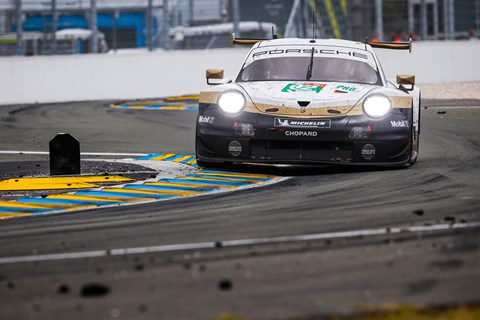
While the fastest cars on track are the LMP1 and LMP2 prototypes, which look closer to fighter jets or alien spacecraft than cars, the GTE class in which Porsche, Aston Martin, Corvette, Ferrari, Ford and BMW compete is where it’s at in Le Mans 2019. The cars look and sound great, and despite the huge difference in size, shape and approach (front-engined battles mid-engined, V8s vs V6s vs flat-sixes, some turbocharged, some not) the racing is incredibly close and exciting. The cars battle in a train, more akin to a karting sprint race than a 24h enduro. One false move and the positions change in the blink of an eye.
Au garage
Night falls and we become a fly on the wall in the Porsche garages, visiting the German Manthey and American IMSA championship squads which share adjacent pitboxes. Both sets of mechanics look shattered already, sat in rows of chairs looking at video feeds and a large digital clock, relentlessly ticking its way through the 24 hours. It’s 9.50pm.
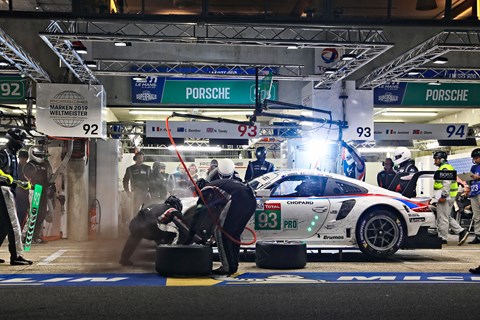
From Le Mans the Manthey crew will head straight to the Nurburgring to the 24h race happening the following weekend, but not before they’ve dissembled the entire building structure at the back of the garage that increases its size three-fold. It takes around two and a half days to build before the race. Inside there are a subset of rooms – a tyre room, with ovens keeping the slicks at optimum temperature and row upon row of spares; a suspension room, with racks of fantastically expensive looking springs and dampers; a bodywork shop, with racks of fresh noses, tails and diffusers, all with transferable liveries and designed to be affixed in a matter of moments. The whole car is engineered to come apart and go back together again quickly. Out front there are further rows of brake components ready to go. It takes 45 seconds to change a whole set, our guide tells us.
There’s also a compact cafeteria area. The mechanics don’t get chance to leave the pit area to eat elsewhere, and they essentially spend 48 hours straight in the garage. There are two coffee machines. They are always running.
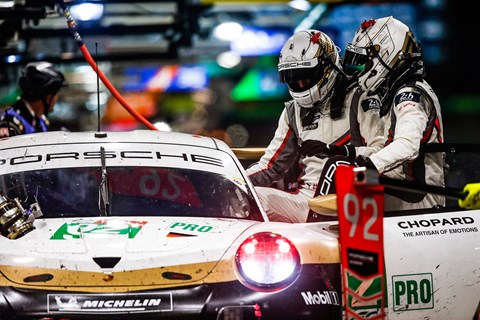
We watch a Manthey pitstop, the team moving as one swift, efficient whole, before the 911 RSR fires up again and departs in an ear-splitting blaze of revs. Nobody looks flustered afterwards; the team returns to their sentry posts, and the coffee machines.
Deviation
In the village of Teloché, a few miles south of Le Mans, there’s an ordinary-looking building that was formerly a garage. From 1951 right the way through to the dawn of Group C racing at the beginning of the 1980s it was the base for Porsche’s Le Mans team, where the cars were prepped and the mechanics stayed before the race.
The cars were driven straight from Teloché to the circuit and reputedly occasionally roared through the streets as shakedown runs between track sessions. Imagine Jacky Ickx’s 936 or Walter Rohrl’s 924 GTP setting off from the sleepy rural village to the Mulsanne entrance…
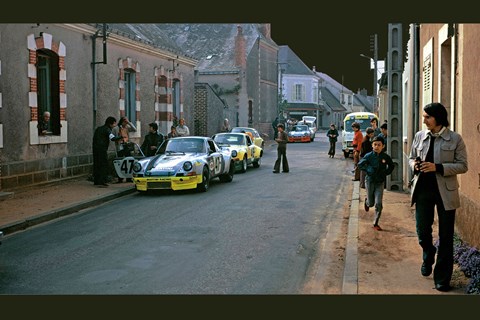
While the race rages on midway through Sunday, we sneak away from the circuit to Teloché in the GT3 RS and a 911 Turbo, the aim being to recreate the 1973 picture above of two 911 Carrera RSRs outside the garage that somehow sums up the style and atmosphere of racing in the ’70s.
The place hasn’t changed; the buildings look identical, right down to the shade of the brickwork.

Refractions of the graft and sweat and hopes and dreams that went on inside that garage have ended up inside the GT3 RS parked outside it today. The feedback through its controls, the tautness yet suppleness of its suspension, all owe a debt to race engineering. Its chassis, aerodynamics, materials, engine innards and more are each a twizzly strand of DNA trailing back through decades of sports car racing. Part of the reason modern-day Porsches drive the way they do is down to lessons learned inside that building and on the circuit nine miles away.
Racing improves the breed? Gosh yes.